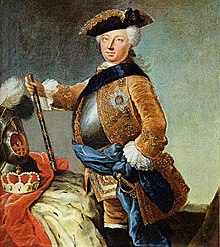Karl Wilhelm Friedrich (Brandenburg-Ansbach)
Karl Wilhelm Friedrich von Brandenburg-Ansbach (* May 12, 1712 in Ansbach ; † August 3, 1757 in Gunzenhausen ), called the Wild Margrave , was sovereign of the Principality of Ansbach from 1729 until his death .
Life
Origin and family
Karl Wilhelm Friedrich was the son of Margrave Wilhelm Friedrich of Brandenburg-Ansbach (1686–1723) and his wife Christiane Charlotte von Württemberg-Winnental (1694–1729). The principality was initially under the rule of his mother.
Karl Wilhelm Friedrich married Friederike Luise von Prussia (1714–1784), daughter of King Friedrich Wilhelm I. The marriage resulted in Karl (1733–1737), who died as a child, and Alexander (1736–1806). Karl Wilhelm Friedrich was a typical absolutist prince who lived a splendid court life: he left his only official heir, Alexander, a debt of 2.3 million Reichstalers; he spent 10 percent of the state budget on his passion for hunting alone. On August 2, 1757, Karl Wilhelm Friedrich died of a stroke .
Karl Wilhelm Friedrich's passion for hunting with the falcons in Weidenbach also had consequences (hence the name wilder Margrave ): With his other partner Elisabeth Wünsch (1710–1757), a falconer's daughter, he had two daughters, Wilhelmine Eleonore (1743–1768) and Louise Charlotte (1746–1747), and two sons. The two sons, Friedrich Karl (1734–1796) and Friedrich Ferdinand Ludwig (1748–1811) were later appointed barons of Falkenhausen . For this purpose, the Ansbach prince had sent his secret councilor Johann Michael Schaudi to the Viennese imperial court, who on this occasion also obtained a letter of nobility for himself. The margrave provided his morganatic sons with material: Friedrich Karl received the castles Thürnhofen and Trautskirchen , Friedrich Ferdinand Ludwig the castles Laufenbürg and Wald bei Gunzenhausen. The castle in Wald was actually built for himself by Carl Friedrich von Zocha , but like the property belonging to it, it had returned to Karl Wilhelm Friedrich after his death, as he had no biological heirs. The Margrave transferred Bibersfeld Castle near Schwäbisch Hall to both sons . The descendants of the Barons von Falkenhausen still live in the castle of Wald.
Absolutistic construction activities
But he also shaped the principality of Ansbach with numerous buildings. For example, he had the Ansbach Palace renovated by the architect Leopoldo Retti and two palace buildings erected in Gunzenhausen and the Georgenthal hunting lodge . 56 new churches and rectories alone were built during his reign. Between 1736 and 1738 he had the Sankt Gumbertus Church in Ansbach expanded and rebuilt in the typical margravial style .
Falcon hunting
His special love was falcon hunting . In 1730 he commissioned his chief architect Carl Friedrich von Zocha to build a falcon and heron house in Triesdorf . Zocha was later replaced by Leopoldo Retti due to differences. According to a list dated June 14, 1748, Karl Wilhelm Friedrich owned the largest falconry in Europe, and between Johanni 1730 and June 1748 he spent more than half a million guilders on this hobby. The prince spared no expense and so two buildings were erected in connection with the hunt: the house in Weidenbach, later called Gut Plein Désir , and the Palais Heydenab in Gunzenhausen , which now houses the commercial bank.
Individual evidence
- ↑ The Eichenhäuser Schloss has its face back ( memento from February 17, 2013 in the web archive archive.today )
literature
- Siegfried Hänle: Karl Wilhelm Friedrich . In: Allgemeine Deutsche Biographie (ADB). Volume 15, Duncker & Humblot, Leipzig 1882, pp. 260-263.
- Werner Mühlhäußer, Siglinde Buchner, Carl-Alexander Mavridis, Sigrid Schwenk: Gunzenhausen. Princely residence under Margrave Carl Wilhelm Friedrich of Brandenburg-Ansbach (ruled 1729–1757) . 2007.
- Günther Schuhmann: Karl Wilhelm Friedrich. In: New German Biography (NDB). Volume 11, Duncker & Humblot, Berlin 1977, ISBN 3-428-00192-3 , p. 223 ( digitized version ).
- Karl Heinrich von Lang : History of the penultimate margrave of Brandenburg-Ansbach . Ansbach 1848 ( e-copy ).
Web links
- Biographical note at rokoko-festspiele.de
- Find Triesdorf
- Family tree in genealogy.euweb.cz
| predecessor | Office | successor |
|---|---|---|
| Wilhelm Friedrich |
Margrave of Brandenburg-Ansbach 1723–1757 |
Alexander |
| personal data | |
|---|---|
| SURNAME | Karl Wilhelm Friedrich |
| ALTERNATIVE NAMES | Brandenburg-Ansbach, Karl Wilhelm Friedrich von (full name) |
| BRIEF DESCRIPTION | Margrave of Brandenburg-Ansbach |
| DATE OF BIRTH | May 12, 1712 |
| PLACE OF BIRTH | Ansbach |
| DATE OF DEATH | August 3, 1757 |
| Place of death | Gunzenhausen |
